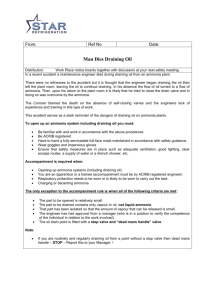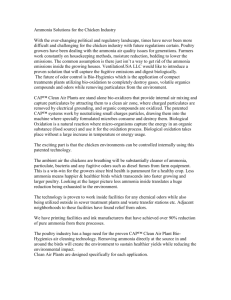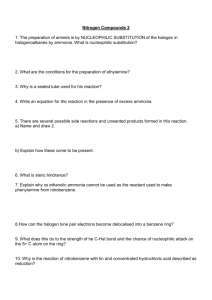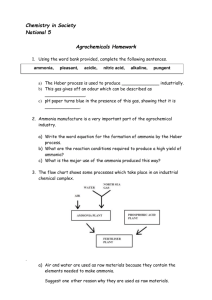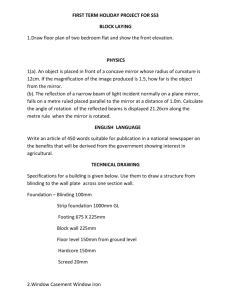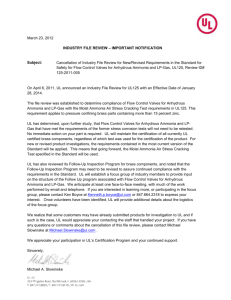Draining oil (ammonia plant)
advertisement
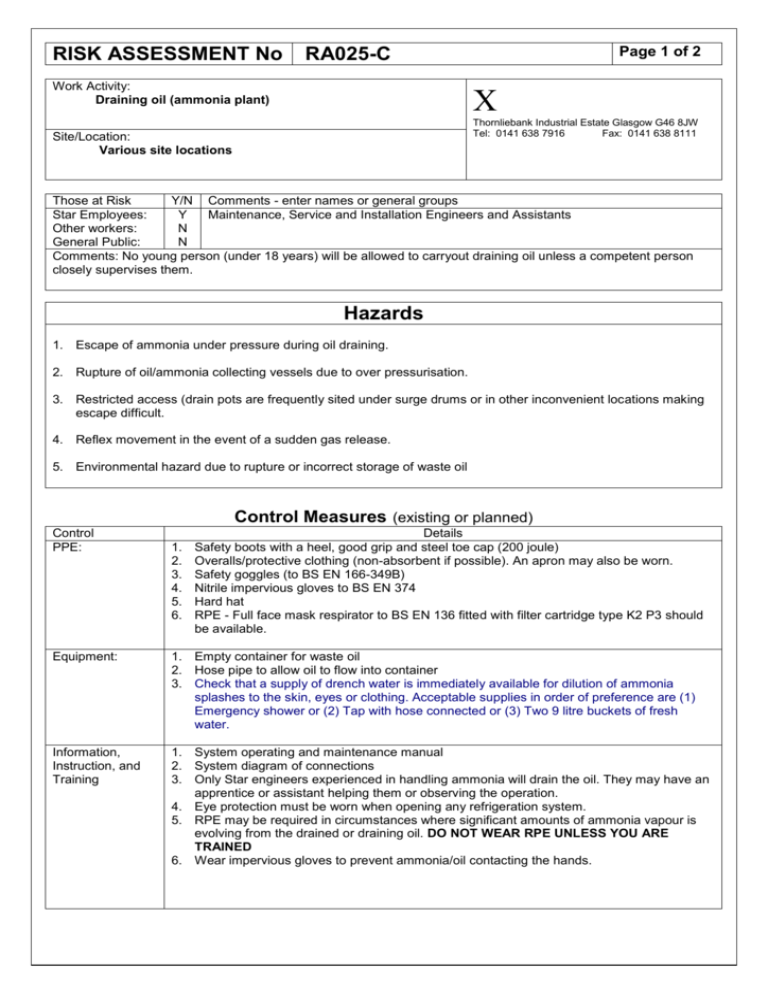
RISK ASSESSMENT No Page 1 of 2 RA025-C Work Activity: Draining oil (ammonia plant) Thornliebank Industrial Estate Glasgow G46 8JW Tel: 0141 638 7916 Fax: 0141 638 8111 Site/Location: Various site locations Those at Risk Y/N Comments - enter names or general groups Star Employees: Y Maintenance, Service and Installation Engineers and Assistants Other workers: N General Public: N Comments: No young person (under 18 years) will be allowed to carryout draining oil unless a competent person closely supervises them. Hazards 1. Escape of ammonia under pressure during oil draining. 2. Rupture of oil/ammonia collecting vessels due to over pressurisation. 3. Restricted access (drain pots are frequently sited under surge drums or in other inconvenient locations making escape difficult. 4. Reflex movement in the event of a sudden gas release. 5. Environmental hazard due to rupture or incorrect storage of waste oil Control Measures (existing or planned) Control PPE: 1. 2. 3. 4. 5. 6. Details Safety boots with a heel, good grip and steel toe cap (200 joule) Overalls/protective clothing (non-absorbent if possible). An apron may also be worn. Safety goggles (to BS EN 166-349B) Nitrile impervious gloves to BS EN 374 Hard hat RPE - Full face mask respirator to BS EN 136 fitted with filter cartridge type K2 P3 should be available. Equipment: 1. Empty container for waste oil 2. Hose pipe to allow oil to flow into container 3. Check that a supply of drench water is immediately available for dilution of ammonia splashes to the skin, eyes or clothing. Acceptable supplies in order of preference are (1) Emergency shower or (2) Tap with hose connected or (3) Two 9 litre buckets of fresh water. Information, Instruction, and Training 1. System operating and maintenance manual 2. System diagram of connections 3. Only Star engineers experienced in handling ammonia will drain the oil. They may have an apprentice or assistant helping them or observing the operation. 4. Eye protection must be worn when opening any refrigeration system. 5. RPE may be required in circumstances where significant amounts of ammonia vapour is evolving from the drained or draining oil. DO NOT WEAR RPE UNLESS YOU ARE TRAINED 6. Wear impervious gloves to prevent ammonia/oil contacting the hands. RISK ASSESSMENT No Page 2 of 2 RA025-C Control Measures Continued Control Supervision: Environment; Procedures, documents etc COSHH: Communications: Emergency action/procedures Access: Waste: Details Supervisors must; 1. Ensure engineers are trained in the safe use of the RPE. 2. Ensure that RPE is subject to recorded monthly maintenance checks (a requirement under COSHH) 3. Ensure that engineers are appropriately trained in handling ammonia 4. Satisfy themselves that oil can be drained safely from individual plants. This may require the writing of site specific risk assessments for unusual or difficult oil draining operations 1. The plant room ventilation should be force run and a door left open to the outside if possible. CHECK YOUR ESCAPE ROUTE IN CASE OF EMERGENCY 1. Oil drain pots should not be isolated from the system unless a suitably rated relief valve is fitted. 2. An assistant or observer should be stationed in the clear air within sight of the person draining the oil to sound alarm should there be excessive ammonia trapped in the oil and the engineer is overcome. 1. The COSHH or product data sheet for the oil being drained and for ammonia should be read. 1. The site maintenance manager should be told that oil is going to be drained. 1. Rescue and action in case of a Leak should be according to the site safety action plan. 2. First Aid procedures are included in Star Technical Bulletin No101 1. Access to the area should be strictly controlled by the engineer draining the oil. 1. Waste oil must be handed to the client or a registered waste operator. 2. Drums of waste oil may be stored indoors or outdoors but if storing outdoors this must be in a suitable bund. 3. Leave the drum open to prevent refrigerant entrained within the oil over pressurising and bursting the drum. However, when storing drums indoors, ensure that the amount of ammonia evolving from the drum is not excessive and does not present an additional hazard in the area. 4. Label the drum to indicate contents. 5. When handing the oil to a waste operator a waste transfer note must be obtained. Risk Evaluation of Identified Hazards Likelihood Highly unlikely = 1 Unlikely = 2 Likely = 3 Severity Slightly harmful = 1 Harmful = 2 Extremely harmful = 3 (Likelihood x Severity = Risk level) 1 = Trivial, 2 = Tolerable, 3-4 = Moderate, 6 = Substantial, 9 = Intolerable Identified Hazards (base scores on existing or planned control measures) Triv' Tol' Mod' Sub' Int' 1. Escape of ammonia under pressure during oil draining. 2x1 2 2. Rupture of oil/ammonia collecting vessels due to over pressurisation. 1x3 3 3. Restricted access (drain pots are frequently sited under surge drums or in other inconvenient locations making escape difficult) 1x3 3 4. Reflex movement in the event of a sudden gas release. 1x2 2 5. Environmental hazard due to rupture or incorrect storage of waste oil 1x2 2 Note: Moderate scores; Thought should be given to reducing risk, but the cost and time requirements of prevention should be carefully considered and limited. Substantial: Work should not be started until the risk has been reduced, for work in progress, urgent action is required. Considerable resources may have to be allocated. Intolerable: If unlimited resources cannot reduce risk, work will be prohibited. Is risk adequately controlled using the above control measures Y/N State further action required: Y If "NO" State further action required Note : This risk assessment is only valid when all control measures are in place before the work or activity commences and will be reviewed 18/02/2012 or earlier if the nature of the work changes or there is a dangerous occurrence. Assessor: Chris Haslam (Sign) Date 18/2/2011 References: HSE Guidance Note PM81 Safe management of ammonia refrigeration systems, Star Technical Bulletin No101 Control of Substances Hazardous to Health Regulations 2002 (COSHH)

